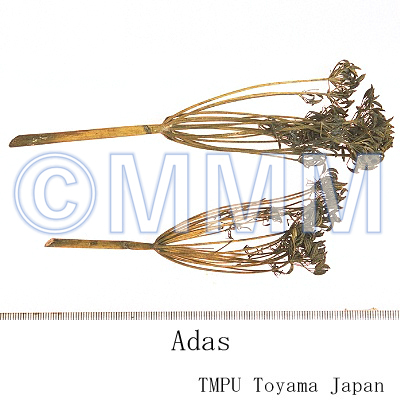Crude drug sample data base
※Click on the image to enlarge it.
Scientific information data base
| Crude drug name | Indonesian name, English name | Biji adas, Fennel | ||||
|---|---|---|---|---|---|---|
| crude drug image |
| |||||
| Original plant name | Foeniculum vulgare Mill. | |||||
| Family name | Umbelliferae | |||||
| Used part | Seeds (fruits) | |||||
| Distribution area | It is probably originated from southern Europe and the Mediterranean. It is cultivated in mountainous regions in Central and East Java (Indonesia), In East Java, it can be found in Tosari in Tengger mountain [201]. | |||||
| Description | The fruit is an ovoid-cylindrical, slightly curved schizocarp, 3-8.5 mm x 2-2.5 mm, light green to yellow-brown, splitting at maturity into 2 mericarps where each has 5 prominent ridges and oil-vittae between the ridges. The plant is a perennial aromatic herb, up to 2 m tall. Leaves alternate, decompound, blade triangular in outline, 2-6 pinnately divided into filiform, acute, blue-green lobes. Inflorescence a terminal, compound umbel. [204]. | |||||
| Drug effect | Neutralizing, fresh odour, camphor-like taste [231]. | |||||
| Specific actions | Anti-inflammatory, carminative, diuretic, anti-microbe [231] | |||||
| Frequency in use | Abundant. | |||||
| Common uses | Fruits are very popular and used as a flavoring agent in various Indonesian dishes in home kitchen. It is used in food industry as a flavour. Fennel is eaten raw as ''lalab''; stem pieces are chewed for their pleasant taste [204]. | |||||
| Pharmacological effect | Essential oil has antibacterial activity and shows spasmolytic effects on smooth muscle of experimental animals [204]. A phenyl propanoid derivative, dillapional was found to be an antimicrobial principle of the stems of Foeniculum vulgare (Umbelliferae) with MIC values of 125, 250 and 125 against Bacillus subtilis, Aspergillus niger and Cladosporium cladosporioides, respectively. A coumarin derivative, scopoletin was also isolated as marginally antimicrobial agent along with inactive compounds, dillapiol, bergapten, imperatorin and psolaren from this plant and were not active against the Escherichia coli [PMID: 12009028]. Hepatoprotective activity of Foeniculum vulgare (fennel) essential oil was studied using carbon tetrachloride induced liver injury model in rats. The results showed that the oil has a potent hepatoprotective action [PMID: 12727504]. Oral administration of Foeniculum vulgarefruit methanolic extract exhibited inhibitory effects against acute and subacute inflammatory diseases and type IV allergic reactions and showed a central analgesic effect. These results support the use of the fruit methanolic extract in relieving inflammation [PMID: 15351109]. A study to evaluate the inhibitory effect of Foeniculum vulgare on contracted tracheal chains of guinea pig indicated that the inhibitory effect of ethanol extracts and essential oil from Foeniculum vulgaree on calcium channels is not contributing to their relaxant (bronchodilatory) effects on guinea pig tracheal chains. However the results suggest a potassium channel opening effect for this plant, which may contribute on its relaxant effect on guinea pig tracheal chains [PMID: 15296096]. | |||||
| Medical system | Indonesian medicine (Jamu) | |||||
| Traditional usage | The fruit is used in combination with bark of Alyxia reinwardtii and popularly known locally as ''adas pulosari'' (adas = F. vulgare, pulosari = Alyxia reinwardtii). The combination is probably meant to impart the flavor of other ingredients in jamu medicines , but it also used to cure mouth ulcer [201, 204]. Fruits are used as carminative and expectorant [201, 231]. | |||||
| Formulation | 1) Sore throat: 2 grams of fennel fruits, 2 pieces of fresh betel leaves, 5 grams of Abrus precatorius leaves, 15 pieces of cardamom fruits. All ingredients are boiled with 115 ml of water to make 100 ml of decoction. Use the decoction as gargle 4 times a day, each with 100 ml of decoction. Repeat for 7 days [231]. 2) Stomach cramps, anorexia, flatulence: 2 grams of fruits of fennel, 3 grams of fresh rhizome of Alpinia galanga, 7 seeds of Parkia biglobosa (stir-fried) are boiled in 110 ml of water to make a decoction. Drink 100 ml of the decoction twice a day for adult. Children should be given 1/4 to 1/2 doses of adults [231]. | |||||
| References | Reference book Tips! | [201] K. Heyne, Tumbuhan Berguna Indonesia, Vols. 1-4, 1987. Diedarkan Oleh Koperasi Karyawan Departemen Kehutanan, Jakarta, Indonesia. Vol. 3, p 1550. [204] de Guzman, C.C. and Siemonsma, J.S. (Editors), 1999. Plant Resources of South-East Asia No. 13 Species. Backhuys Publishers, Leiden, Netherlands. pp 126-130. [222] P.T. Eisai Indonesia: Medical Herb Index in Indonesia (Second edition).1995. p 182. [231] Soedibyo, Mooryati: Alam Sumber Kesehatan: Manfaat dan Kegunaan (Natural resources for health. Benefits and uses). Balai Pustaka. 1998. pp 50-51. | ||||
| Research paper | 1. Choi EM, Hwang JK. Antiinflammatory, analgesic and antioxidant activities of the fruit of Foeniculum vulgare. Fitoterapia. 75(6):557-65, 2004. (PMID: 15351109) 2. Boskabady MH, Khatami A, Nazari A. Possible mechanism(s) for relaxant effects of Foeniculum vulgare on guinea pig tracheal chains. Pharmazie. 59(7):561-4, 2004. (PMID: 15296096) 3. Ozbek H, Uğraş S, Dulger H, Bayram I, Tuncer I, Ozturk G, Ozturk A. Hepatoprotective effect of Foeniculum vulgare essential oil. Fitoterapia. 74(3):317-9, 2003. (PMID: 12727504) 4. Kwon YS, Choi WG, Kim WJ, Kim WK, Kim MJ, Kang WH, Kim CM. Antimicrobial constituents of Foeniculum vulgare. Arch Pharm Res. 25(2):154-7, 2002. (PMID: 12009028) | |||||
| Last renewal date | 2024/02/29 | |||||







